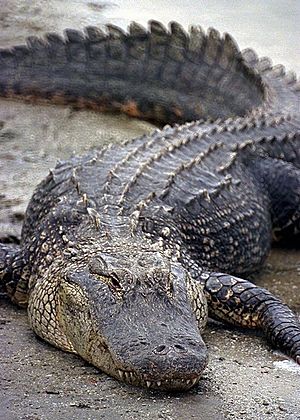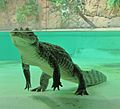Alligatoridae facts for kids
Quick facts for kids Alligatoridae |
|
|---|---|
 |
|
| American alligator (Alligator mississippiensis) | |
| Scientific classification |
|
| Kingdom: | Animalia |
| Phylum: | Chordata |
| Class: | Reptilia |
| Order: | Crocodilia |
| Clade: | Globidonta |
| Family: | Alligatoridae Gray, 1844 |
| Subfamilies | |
|
|
Alligators and Caimans are a special group of large reptiles that belong to the family Alligatoridae. They are part of the larger group called crocodilians, which also includes crocodiles and gharials. There are about 7 known species of alligators and caimans alive today.
These amazing creatures come in different sizes. For example, the Chinese alligator (Alligator sinensis) is usually about 1.5 metres (4.9 ft) long. The American Alligator (A. mississippiensis) is much bigger, typically around 4 m (13 ft). The largest American alligator ever recorded was an incredible 5.79 m (19.0 ft) long! The Black Caiman, found in the Amazon, can grow even larger, up to 6 m (20 ft).
Alligators and caimans live in warm, wet places. You can find them in the southern United States, Central America, northern South America, and near the Yangzee river in China.
Contents
Alligators and Crocodiles: What's the Difference?
Have you ever wondered how to tell an alligator from a crocodile? There are a few cool differences!
- Snout Shape: Alligators usually have shorter, wider snouts that look more like a "U" shape. Crocodiles tend to have longer, pointier snouts that look more like a "V".
- Teeth: When an alligator closes its mouth, the fourth tooth on its lower jaw fits neatly into a special pit in its upper jaw, so you can't see it. With crocodiles, this same tooth sticks out and is visible on the outside of their upper jaw.
- Habitat: Alligators prefer fresh water, like rivers, lakes, and swamps. Crocodiles can live in both fresh water and saltwater. This is because crocodiles have special glands that help them get rid of extra salt from their bodies, which alligators don't have.
- Temperament: Alligators are generally less aggressive than crocodiles. While it's always important to be careful around any wild animal, only the largest alligators are typically considered a threat to humans.
Meet the Alligator and Caiman Species
The Alligatoridae family includes two main groups: alligators and caimans. Here are some of the living species you might learn about:
Alligators
- Chinese Alligator (Alligator sinensis): This smaller alligator lives only in China and is critically endangered.
- American Alligator (Alligator mississippiensis): The most well-known alligator, found in the southeastern United States.
Caimans
Caimans are found in Central and South America.
- Cuvier's Dwarf Caiman (Paleosuchus palpebrosus): One of the smallest crocodilians.
- Smooth-fronted Caiman (Paleosuchus trigonatus): Another smaller caiman species.
- Yacare Caiman (Caiman yacare): Found in wetlands like the Pantanal.
- Spectacled Caiman (Caiman crocodilus): Named for a bony ridge between its eyes that looks like spectacles.
- Broad-snouted Caiman (Caiman latirostris): Known for its wide snout.
- Black Caiman (Melanosuchus niger): The largest predator in the Amazon ecosystem.
Images for kids
-
C. crocodilus at the Helsinki Tropicario Zoo aquarium in Helsinki, Finland in 2010
-
An alligator nest at Everglades National Park, Florida, United States
-
Spectacled caiman head
-
Black caiman, Jauaperi River, Amazonia
-
Head of smooth-fronted caiman
See also
 In Spanish: Aligatóridos para niños
In Spanish: Aligatóridos para niños








